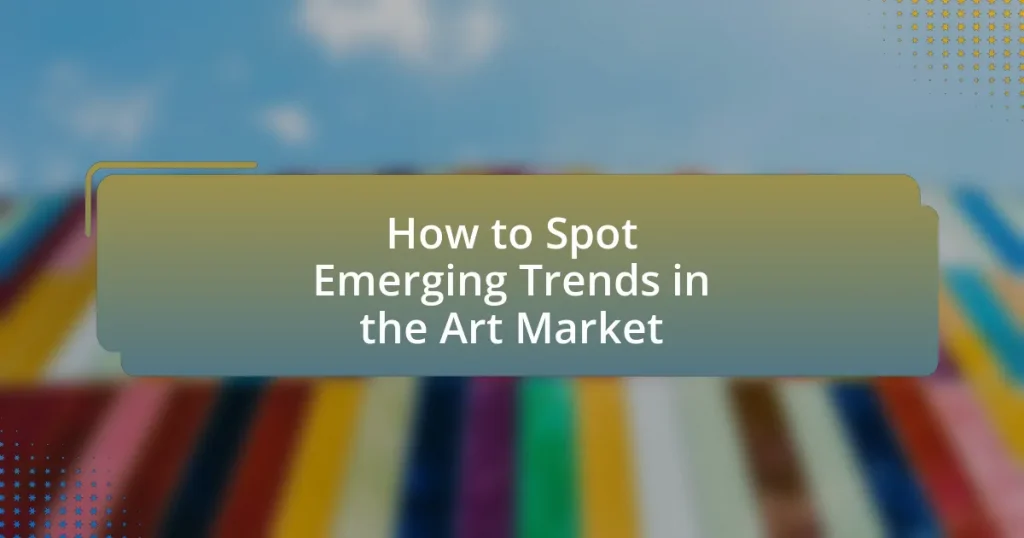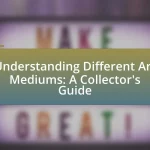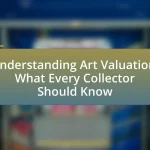The article focuses on identifying emerging trends in the art market, highlighting key developments such as the rise of digital art and NFTs, increased interest in sustainability, and the influence of social media on art sales. It outlines methods for trend identification, including data analysis, market research, and monitoring consumer behavior. The article emphasizes the importance of recognizing these trends for informed investment decisions and discusses the role of art fairs, galleries, and online platforms in shaping market dynamics. Additionally, it provides insights into best practices for collectors and investors to stay ahead in a rapidly evolving art landscape.
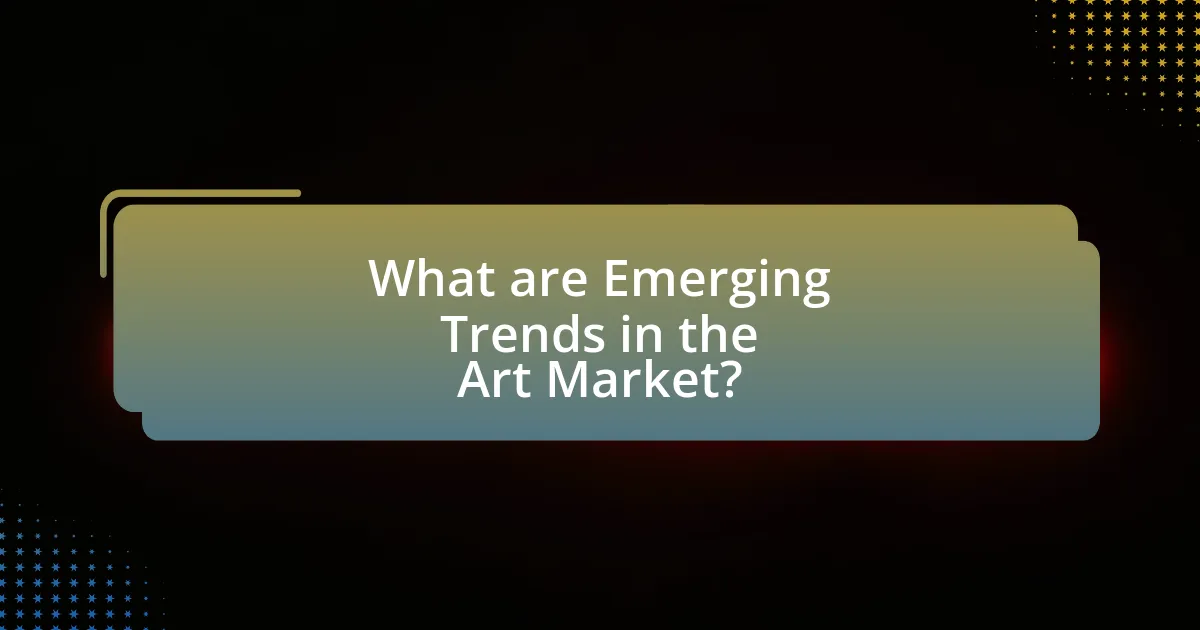
What are Emerging Trends in the Art Market?
Emerging trends in the art market include the rise of digital art, particularly NFTs, increased interest in sustainability, and the growing influence of social media on art sales. Digital art has gained significant traction, with NFT sales reaching over $10 billion in 2021, showcasing a shift towards blockchain technology in art transactions. Sustainability is becoming a priority, as artists and collectors increasingly seek eco-friendly materials and practices, reflecting broader societal concerns. Additionally, social media platforms like Instagram and TikTok are reshaping how artists promote their work and connect with audiences, leading to new sales channels and market dynamics.
How can we identify these trends?
To identify emerging trends in the art market, one can analyze sales data, auction results, and gallery exhibitions. By examining the frequency and pricing of artworks sold, as well as the types of artists gaining visibility, patterns can be discerned that indicate shifting preferences among collectors and institutions. For instance, a report by Art Basel and UBS in 2021 highlighted a significant increase in online art sales, suggesting a trend towards digital engagement in the market. Additionally, monitoring social media platforms and art fairs can provide insights into popular themes and styles, further aiding in the identification of trends.
What indicators signal the emergence of new trends?
Indicators that signal the emergence of new trends in the art market include shifts in consumer preferences, increased social media engagement, and changes in auction results. For instance, a notable rise in online art sales, which grew by 25% in 2020 according to Art Basel and UBS, reflects changing consumer behavior and a growing acceptance of digital platforms. Additionally, the emergence of new artists gaining traction on social media platforms like Instagram can indicate a shift in aesthetic preferences and market demand. Monitoring these factors provides insight into evolving trends within the art market.
How do market dynamics influence trend identification?
Market dynamics significantly influence trend identification by shaping the supply and demand landscape within the art market. Changes in consumer preferences, economic conditions, and technological advancements can alter how trends emerge and are recognized. For instance, during economic booms, there is often increased investment in contemporary art, leading to a surge in demand for specific styles or artists, which can signal emerging trends. Additionally, data from art sales and auction results can provide concrete evidence of shifting interests, as seen in the rise of digital art and NFTs, which gained traction due to advancements in technology and changing consumer behavior. Thus, understanding these dynamics is crucial for accurately identifying and forecasting trends in the art market.
Why is it important to spot these trends?
Spotting trends in the art market is crucial for making informed investment decisions. By identifying emerging trends, investors can capitalize on shifts in consumer preferences and market dynamics, leading to potential financial gains. For instance, a report by Art Basel and UBS in 2021 indicated that the global art market reached $65.1 billion, highlighting the importance of recognizing trends to navigate this lucrative sector effectively. Understanding these trends allows stakeholders to anticipate changes, adapt strategies, and enhance their competitive advantage in a rapidly evolving market.
What impact do emerging trends have on artists and collectors?
Emerging trends significantly influence artists and collectors by shaping market dynamics and altering creative practices. Artists often adapt their styles and mediums to align with current trends, which can enhance their visibility and sales potential. For instance, the rise of digital art and NFTs has opened new revenue streams for artists, allowing them to reach broader audiences and engage with collectors in innovative ways. Collectors, on the other hand, are increasingly drawn to artworks that reflect contemporary themes and technologies, impacting their purchasing decisions. According to a report by Art Basel and UBS, the global art market reached $65.1 billion in 2018, with a notable increase in online sales driven by emerging digital trends. This data underscores the importance of staying attuned to trends for both artists and collectors, as it directly affects their engagement and investment in the art market.
How can understanding trends enhance investment strategies?
Understanding trends enhances investment strategies by enabling investors to make informed decisions based on market movements and consumer preferences. By analyzing historical data and current market dynamics, investors can identify patterns that indicate potential growth areas. For instance, a report from Art Basel and UBS in 2021 highlighted that the global art market reached $65.1 billion, with online sales growing by 25% year-over-year, showcasing a shift towards digital platforms. This trend indicates that investors focusing on online art sales may capitalize on emerging opportunities. Thus, recognizing and adapting to these trends allows investors to optimize their portfolios and maximize returns.

What Sources Can Help in Spotting Trends?
Sources that can help in spotting trends in the art market include art fairs, auction results, social media platforms, and art market reports. Art fairs, such as Art Basel and Frieze, showcase emerging artists and new works, providing insights into current market preferences. Auction results from major houses like Sotheby’s and Christie’s reveal which artists and styles are gaining traction, as evidenced by increasing sale prices and bidding activity. Social media platforms, particularly Instagram, allow for real-time engagement with art communities, highlighting popular artists and movements. Additionally, art market reports from organizations like Artprice and The Art Market Report by Clare McAndrew offer data-driven analyses of market trends, including sales statistics and demographic shifts. These sources collectively provide a comprehensive view of the evolving landscape in the art market.
How do art fairs and exhibitions contribute to trend spotting?
Art fairs and exhibitions significantly contribute to trend spotting by providing a concentrated platform for artists, galleries, and collectors to showcase and discover new works. These events facilitate direct interaction among stakeholders, allowing for immediate feedback and discussions about emerging styles and themes. For instance, the Armory Show in New York has historically highlighted avant-garde artists, influencing market trends by showcasing innovative practices and concepts. Additionally, the presence of diverse international participants at events like Art Basel exposes attendees to a wide range of artistic expressions, helping to identify shifts in aesthetic preferences and cultural narratives. This dynamic environment enables trend analysts to observe patterns in audience engagement and sales, further solidifying the role of art fairs and exhibitions as critical indicators of market evolution.
What role do galleries play in showcasing emerging artists?
Galleries play a crucial role in showcasing emerging artists by providing them with a platform to display their work to a broader audience. This exposure is essential for artists who are in the early stages of their careers, as galleries often curate exhibitions that highlight new talent, thereby increasing visibility and credibility. According to a study by the National Endowment for the Arts, galleries significantly contribute to the professional development of artists by facilitating connections with collectors, critics, and other industry professionals. This networking can lead to sales, commissions, and further exhibition opportunities, which are vital for the sustainability of an emerging artist’s career.
How can social media platforms influence art trends?
Social media platforms can significantly influence art trends by providing artists and audiences with a space to share, discover, and engage with new artistic expressions. These platforms facilitate rapid dissemination of visual content, allowing trends to emerge quickly as artists showcase their work and gain followers. For instance, Instagram’s visual-centric format has led to the rise of specific styles, such as digital art and street art, as users share and promote these forms widely. Additionally, algorithms on platforms like TikTok can propel certain artworks or styles into viral status, impacting what is considered trendy in the art world. This phenomenon is supported by data showing that 67% of artists report that social media has helped them gain visibility and influence in their respective fields.
What publications and reports are valuable for trend analysis?
Valuable publications and reports for trend analysis in the art market include the Art Basel and UBS Global Art Market Report, which provides comprehensive insights into market dynamics and sales trends. Additionally, the Hiscox Online Art Trade Report offers data on online art sales and consumer behavior, while the TEFAF Art Market Report analyzes global art market trends and economic factors influencing them. These reports are widely recognized for their rigorous research methodologies and are frequently cited by industry professionals to inform investment decisions and market strategies.
Which art market reports should collectors follow?
Collectors should follow the Art Basel and UBS Global Art Market Report, as it provides comprehensive insights into market trends, sales data, and collector behavior. This report is published annually and is widely regarded as a key resource for understanding the dynamics of the global art market. Additionally, the Hiscox Online Art Trade Report offers valuable information on online art sales and emerging digital trends, which are increasingly relevant in today’s market. These reports are backed by extensive research and data analysis, making them essential tools for collectors aiming to identify and capitalize on emerging trends in the art market.
How do online platforms provide insights into market trends?
Online platforms provide insights into market trends by aggregating and analyzing data from user interactions, sales transactions, and social media engagement. These platforms utilize algorithms to track changes in consumer preferences, pricing fluctuations, and emerging artists, allowing them to identify patterns and predict future trends. For instance, platforms like Artsy and Saatchi Art analyze user behavior and sales data to highlight popular styles and mediums, providing valuable information to collectors and investors. This data-driven approach enables stakeholders in the art market to make informed decisions based on real-time insights.
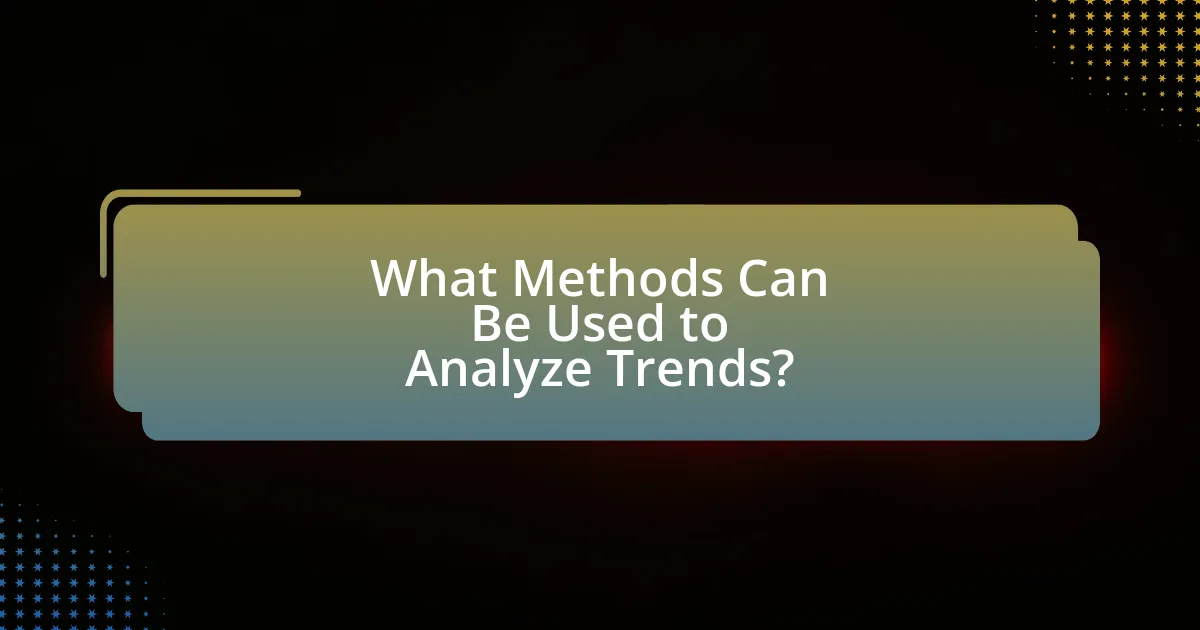
What Methods Can Be Used to Analyze Trends?
To analyze trends in the art market, methods such as data analysis, market research, and social media monitoring can be employed. Data analysis involves examining sales data, auction results, and gallery performance to identify patterns over time. Market research includes surveys and interviews with collectors, artists, and galleries to gather insights on preferences and emerging interests. Social media monitoring tracks discussions and engagement around artists and artworks, providing real-time insights into public sentiment and emerging trends. These methods collectively enable stakeholders to make informed decisions based on concrete evidence from the art market landscape.
How can data analytics aid in trend identification?
Data analytics aids in trend identification by systematically analyzing large datasets to uncover patterns and insights. By employing techniques such as statistical analysis, machine learning, and data visualization, analysts can detect shifts in consumer preferences, pricing trends, and emerging styles within the art market. For instance, a study by McKinsey & Company found that data-driven insights can lead to a 5-6% increase in profitability for companies that effectively leverage analytics. This demonstrates that data analytics not only identifies trends but also enhances decision-making processes, allowing stakeholders in the art market to respond proactively to changes.
What tools are available for analyzing art market data?
Tools available for analyzing art market data include Artprice, Artnet, and Artsy. Artprice provides a comprehensive database of auction results and market trends, allowing users to track price fluctuations and artist performance over time. Artnet offers similar auction data along with analytics tools that help users assess market demand and value. Artsy combines auction data with gallery listings and exhibitions, providing insights into emerging artists and trends. These platforms are widely used by collectors, investors, and researchers to make informed decisions in the art market.
How can historical data inform current trend analysis?
Historical data can inform current trend analysis by providing a foundation for understanding patterns and shifts over time. By examining past sales, artist popularity, and market fluctuations, analysts can identify recurring trends and predict future movements in the art market. For instance, data from the Art Basel and UBS Global Art Market Report shows that auction sales have increased significantly over the past decade, indicating a growing interest in contemporary art. This historical context allows stakeholders to make informed decisions based on established patterns, enhancing their ability to spot emerging trends effectively.
What qualitative methods can enhance trend analysis?
Qualitative methods that can enhance trend analysis include interviews, focus groups, and content analysis. Interviews allow for in-depth insights from artists, collectors, and critics, revealing nuanced perspectives on emerging trends. Focus groups facilitate discussions among diverse stakeholders, generating collective insights that highlight shifts in preferences and behaviors. Content analysis of social media, art reviews, and exhibition catalogs provides data on public sentiment and emerging themes, enabling analysts to identify patterns and trends in the art market. These methods collectively contribute to a richer understanding of the dynamics influencing art trends.
How can interviews with industry experts provide insights?
Interviews with industry experts can provide insights by leveraging their specialized knowledge and experience to identify emerging trends in the art market. Experts often possess a deep understanding of market dynamics, consumer behavior, and historical context, which enables them to forecast future developments accurately. For instance, a study by the Art Market Research Institute found that expert opinions significantly correlate with market shifts, as they can analyze data and patterns that may not be immediately apparent to the general public. This access to nuanced perspectives allows stakeholders to make informed decisions based on credible forecasts and analyses.
What role does consumer behavior play in understanding trends?
Consumer behavior is crucial in understanding trends as it reveals the preferences, motivations, and purchasing patterns of individuals. By analyzing consumer behavior, businesses and analysts can identify shifts in demand, emerging interests, and potential market opportunities. For instance, a study by the National Endowment for the Arts found that consumer engagement with contemporary art has increased, indicating a trend towards modern artistic expressions. This data illustrates how tracking consumer behavior can provide insights into evolving trends within the art market, enabling stakeholders to adapt their strategies accordingly.
What are the best practices for spotting emerging trends?
The best practices for spotting emerging trends include conducting thorough market research, analyzing consumer behavior, and leveraging social media insights. Market research provides data on sales patterns and artist popularity, which can indicate shifts in demand. Analyzing consumer behavior through surveys and focus groups reveals preferences and emerging interests. Social media platforms, such as Instagram and Pinterest, serve as valuable tools for identifying trends, as they showcase real-time engagement with art and artists. According to a report by Art Basel and UBS, 70% of collectors use social media to discover new artists, highlighting its effectiveness in trend spotting.
How can one develop a keen eye for art market changes?
To develop a keen eye for art market changes, one should consistently analyze auction results, gallery exhibitions, and art fairs. Regularly reviewing auction house reports, such as those from Sotheby’s and Christie’s, provides insights into price fluctuations and emerging artists. Additionally, following art market publications like Artprice and The Art Newspaper can help track trends and shifts in collector preferences. Engaging with art communities through social media platforms and attending industry events fosters connections that reveal insider perspectives on market dynamics. This approach is validated by the fact that informed collectors and investors often outperform the market by staying updated on these critical indicators.
What strategies should collectors adopt to stay ahead of trends?
Collectors should adopt a proactive approach by engaging in continuous research and networking within the art community to stay ahead of trends. This involves regularly attending art fairs, exhibitions, and auctions to observe emerging artists and styles. Additionally, following influential art critics and publications can provide insights into upcoming trends. Data from the Art Basel and UBS Global Art Market Report indicates that collectors who actively participate in the art market and stay informed about market dynamics are more likely to make informed purchasing decisions. By leveraging these strategies, collectors can effectively anticipate shifts in the art market and enhance their collections.










